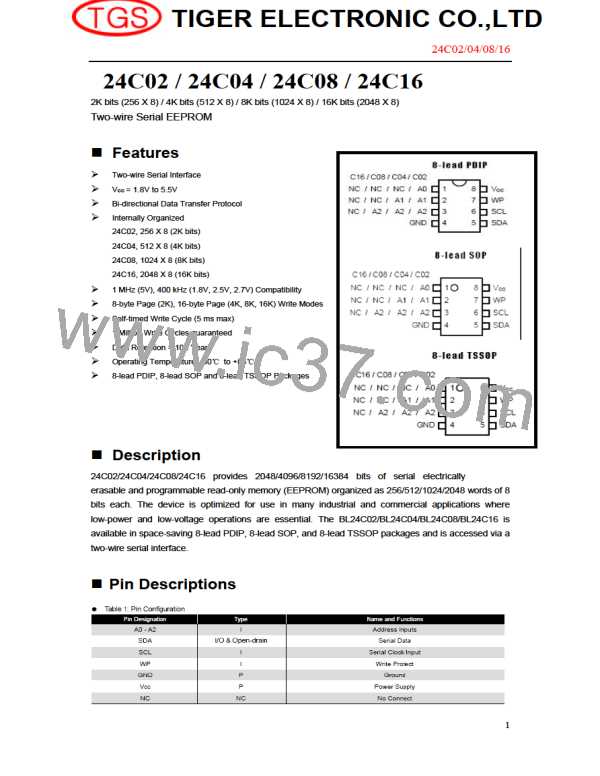24C02/04/08/16
A0 pin is no connect.
The 8K EEPROM only uses the A2 device address bit with the next 2 bits being for memory page
addressing. The A2 bit must compare to its corresponding hard-wired input pin. The A1 and A0 pins are
no connect.
The 16K does not use any device address bits but instead the 3 bits are used for memory page
addressing. These page addressing bits on the 4K, 8K and 16K devices should be considered the most
significant bits of the data word address which follows. The A0, A1 and A2 pins are no connect.
The eighth bit of the device address is the read/write operation select bit. A read operation is initiated if
this bit is high and a write operation is initiated if this bit is low.
Upon a compare of the device address, the EEPROM will output a "0". If a compare is not made, the chip
will return to a standby state.
ꢀWrite Operations
BYTE WRITE: A write operation requires an 8-bit data word address following the device address word
and acknowledgment. Upon receipt of this address, the EEPROM will again respond with a "0" and then
clock in the first 8-bit data word. Following receipt of the 8-bit data word, the EEPROM will output a "0"
and the addressing device, such as a microcontroller, must terminate the write sequence with a stop
condition. At this time the EEPROM enters an internally timed write cycle, tWR, to the nonvolatile
memory. All inputs are disabled during this write cycle and the EEPROM will not respond until the write is
complete (see Figure 5 on page 7).
PAGE WRITE: The 2K EEPROM is capable of an 8-byte page write, and the 4K, 8K and 16K devices are
capable of 16-byte page writes.
A page write is initiated the same as a byte write, but the microcontroller does not send a stop condition
after the first data word is clocked in. Instead, after the EEPROM acknowledges receipt of the first data
word, the microcontroller can transmit up to seven (2K) or fifteen (4K, 8K, 16K) more data words. The
EEPROM will respond with a "0" after each data word received. The microcontroller must terminate the
page write sequence with a stop condition (see Figure 6 on page 7).
The data word address lower three (2K) or four (4K, 8K, 16K) bits are internally incremented following the
receipt of each data word. The higher data word address bits are not incremented, retaining the memory
page row location. When the word address, internally generated, reaches the page boundary, the
following byte is placed at the beginning of the same page. If more than eight (2K) or sixteen (4K, 8K,
16K) data words are transmitted to the EEPROM, the data word address will "roll over" and previous data
6

 TGS [ Tiger Electronic Co.,Ltd ]
TGS [ Tiger Electronic Co.,Ltd ]